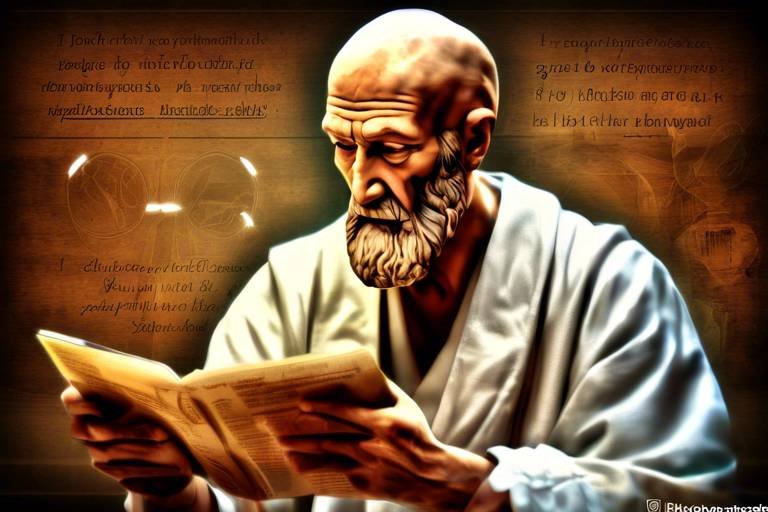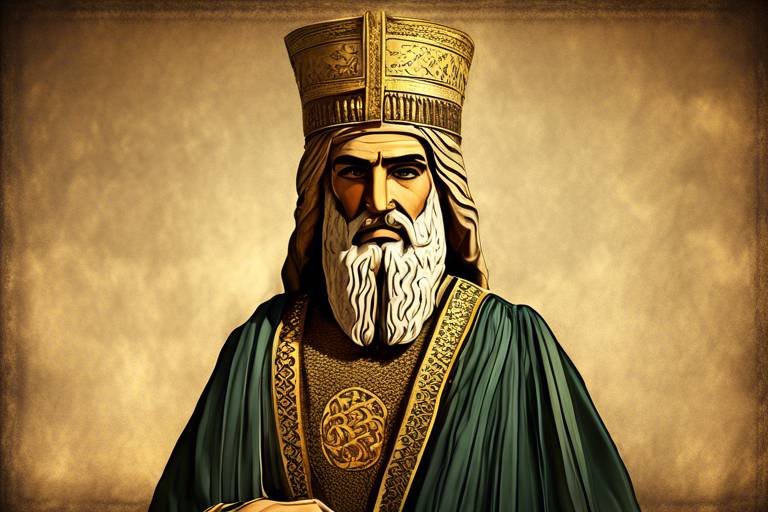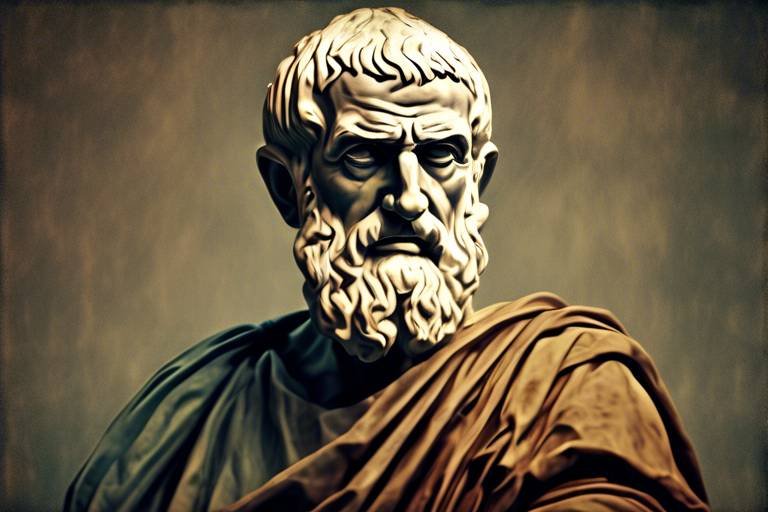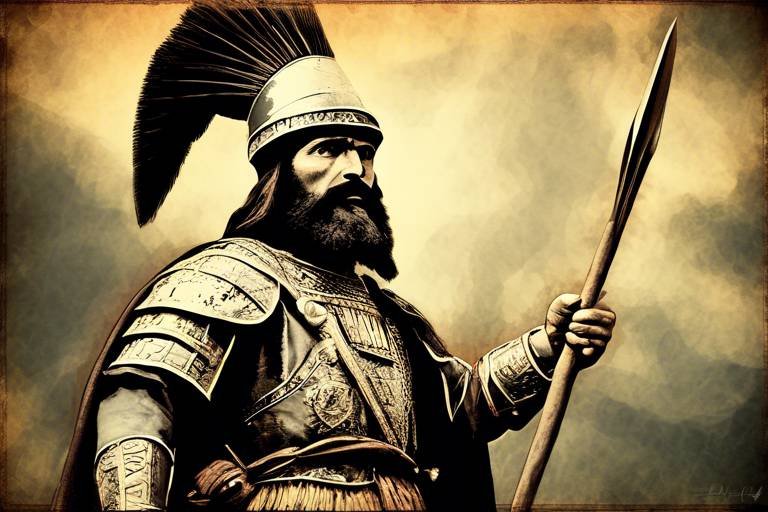Ptolemy: The Astronomer and Geographer
Ptolemy, a towering figure in ancient Greek astronomy and geography, stands as a beacon of knowledge and innovation in the annals of history. His pioneering work not only revolutionized our understanding of the cosmos and the world but also laid the groundwork for future generations to build upon.

Early Life and Background
Ptolemy, a prominent figure in ancient Greek astronomy and geography, was born in the city of Ptolemais Hermiou in Egypt, around 100 AD. Little is known about his early life and upbringing, but it is believed that he received a comprehensive education in mathematics, philosophy, and astronomy. Growing up in a diverse cultural environment, Ptolemy was exposed to a wide range of ideas and influences that would later shape his intellectual pursuits.
As a young scholar, Ptolemy was fascinated by the movements of celestial bodies and the mysteries of the cosmos. Inspired by the works of earlier astronomers and philosophers, such as Aristotle and Hipparchus, he began his quest to unravel the secrets of the universe. His early experiences in observing the night sky and studying the works of his predecessors laid the foundation for his future contributions to astronomy and geography.
Ptolemy's interest in astronomy and geography was not only driven by intellectual curiosity but also by a desire to understand the world around him. Living in a time of great intellectual ferment, he was exposed to a wealth of knowledge and ideas that fueled his passion for exploration and discovery. The cultural diversity of the ancient world provided Ptolemy with a rich tapestry of influences that shaped his worldview and set him on a path of scientific inquiry.

Astronomical Achievements
Ptolemy, the renowned astronomer and geographer of ancient Greece, is best known for his remarkable astronomical achievements that revolutionized the understanding of the cosmos. One of his most significant contributions was the development of the geocentric model of the universe, which posited that the Earth was the center of the universe with all celestial bodies revolving around it. This model, known as the Ptolemaic system, dominated scientific thought for centuries and influenced astronomical observations and calculations.
Furthermore, Ptolemy's work in astronomy extended to his meticulous documentation of the movements of planets and stars. Through his observations and mathematical calculations, he was able to predict the positions of celestial bodies with remarkable accuracy, laying the groundwork for future astronomers and navigators.
One of Ptolemy's key achievements was his publication of the influential astronomical treatise known as the Almagest, which synthesized the astronomical knowledge of his time and provided a comprehensive overview of the geocentric model. This monumental work not only served as a guide for astronomers for centuries but also showcased Ptolemy's mastery of observational data and mathematical precision.
Moreover, Ptolemy's contributions to astronomy went beyond theoretical models. He also developed innovative instruments, such as the astrolabe and the armillary sphere, to aid in astronomical observations and measurements. These tools revolutionized the way astronomers studied the heavens and paved the way for future advancements in observational astronomy.
In conclusion, Ptolemy's astronomical achievements were groundbreaking in their scope and impact, shaping the course of scientific inquiry for centuries to come. His meticulous observations, mathematical prowess, and theoretical insights continue to inspire astronomers and scientists to this day, highlighting the enduring legacy of this ancient scholar.

Geographical Contributions
Ptolemy's contributions to the field of geography were as significant as his astronomical achievements. One of his most notable works was the creation of a world map that influenced cartography for centuries to come. This map, although imperfect by modern standards, provided a comprehensive view of the known world at that time. Ptolemy also introduced the concept of longitude and latitude, which revolutionized navigation and exploration.
In his geographical studies, Ptolemy utilized a combination of mathematical calculations and observational data to plot the positions of various landmarks and cities on his map. His methodology involved intricate measurements and calculations to accurately represent the Earth's surface. This attention to detail and precision set a high standard for future cartographers and explorers.
Furthermore, Ptolemy's map was not just a static representation but a dynamic tool for understanding the world. It allowed travelers and traders to plan their journeys more effectively and navigate with greater confidence. The accuracy and detail of his map provided a foundation for the Age of Exploration, shaping the course of history through the centuries.
Despite some inaccuracies and limitations in his geographical work, Ptolemy's contributions laid the groundwork for modern cartography and geographic understanding. His innovative approaches to mapping and spatial representation continue to influence how we perceive and interact with the world around us.

Legacy and Influence
Exploring the legacy and influence of Ptolemy reveals the profound impact his work had on the fields of astronomy and geography. Ptolemy's theories and methodologies not only revolutionized the way ancient scholars viewed the cosmos and mapped the Earth but also laid the groundwork for future scientific advancements.
One of Ptolemy's most enduring legacies is his geocentric model of the universe, which posited that the Earth was at the center of the cosmos with celestial bodies orbiting around it. This model, known as the Ptolemaic system, dominated astronomical thought for centuries and shaped the way people conceptualized the heavens.
In the realm of geography, Ptolemy's contributions were equally significant. His world map, created using a grid of longitude and latitude lines, revolutionized cartography and provided a framework for understanding the Earth's surface. Ptolemy's methods of mapmaking influenced explorers for generations, guiding their voyages and shaping their understanding of the world.
Moreover, Ptolemy's legacy extends beyond his specific theories and models. His emphasis on empirical observation, mathematical precision, and systematic analysis set a standard for scientific inquiry that continues to influence researchers today. By combining theoretical speculation with practical measurement, Ptolemy established a methodology that remains foundational to the scientific method.
Throughout history, Ptolemy's work has been subject to reinterpretation and adaptation. Scholars and scientists have built upon his ideas, refining his models and incorporating new discoveries to expand our understanding of the cosmos and the Earth. Ptolemy's willingness to question existing beliefs and explore the unknown paved the way for future generations to push the boundaries of knowledge.

Controversies and Criticisms
Throughout history, Ptolemy's astronomical and geographical theories have sparked intense debates and controversies among scholars and scientists. One of the most significant criticisms of Ptolemy's work revolves around his geocentric model of the universe, which posited that the Earth was at the center of the cosmos. This theory clashed with the emerging heliocentric model proposed by other ancient astronomers, such as Aristarchus of Samos.
Moreover, modern scholars have scrutinized the accuracy of Ptolemy's astronomical observations and the mathematical calculations he used to support his theories. Some critics argue that his reliance on complex epicycles and deferents to explain the motion of celestial bodies introduced unnecessary complications into his models, leading to inaccuracies in predicting planetary positions.
Another point of contention is the issue of retrograde motion in the Ptolemaic system, where planets appear to move backward in the sky. Critics have pointed out inconsistencies in Ptolemy's explanations for this phenomenon, questioning the validity of his assumptions about the paths of planetary orbits.
Furthermore, Ptolemy's geographical contributions have also faced scrutiny, particularly regarding the accuracy of his world map and the methods he used to determine longitude and latitude. Some scholars argue that his reliance on existing data and estimates from earlier explorers led to distortions in his maps, impacting the precision of geographical knowledge during his time.
In light of these controversies and criticisms, it is essential to recognize the limitations of Ptolemy's theories and the ongoing debates that shape our understanding of the ancient world's scientific achievements. While his work laid the groundwork for future advancements in astronomy and geography, it also serves as a reminder of the complexities and uncertainties inherent in the pursuit of knowledge.

Historical Context
When exploring the historical context in which Ptolemy lived and worked, it is essential to consider the intellectual climate of ancient Greece. During Ptolemy's time, ancient Greek scholars were actively engaged in philosophical and scientific inquiries, seeking to understand the natural world and the cosmos. The legacy of earlier scholars, such as Aristotle and Euclid, greatly influenced Ptolemy's approach to astronomy and geography.
Moreover, the cultural and societal factors of the Hellenistic period played a significant role in shaping Ptolemy's scientific pursuits. The flourishing of knowledge and the exchange of ideas in cosmopolitan centers like Alexandria provided a fertile ground for intellectual exploration. Ptolemy's work was not only a product of his individual genius but also a reflection of the broader intellectual currents of his time.
Within this vibrant intellectual landscape, Ptolemy engaged with diverse traditions and sources of knowledge, incorporating insights from Babylonian, Egyptian, and Greek scholars. His synthesis of these diverse influences resulted in a rich tapestry of astronomical and geographical theories that laid the groundwork for future scientific advancements.
Furthermore, the historical context of Ptolemy's era was marked by the transmission and preservation of knowledge. The translation of ancient texts into Greek, the establishment of libraries, and the patronage of scholars by rulers all contributed to the dissemination of scientific ideas. Ptolemy's own writings, including the influential "Almagest" and "Geography," were instrumental in preserving and transmitting knowledge to later generations.
In conclusion, understanding the historical context in which Ptolemy lived illuminates the intellectual milieu that shaped his pioneering work in astronomy and geography. By situating Ptolemy within the broader tapestry of ancient Greek scholarship and cultural exchange, we gain a deeper appreciation of his enduring legacy in the history of science.

Methodology and Tools
When it comes to exploring the methodology and tools utilized by Ptolemy in his groundbreaking astronomical and geographical research, it becomes evident that his work was not only innovative but also incredibly meticulous. Ptolemy's methodology was deeply rooted in the principles of observation, measurement, and mathematical analysis.
One of the key tools that Ptolemy employed in his astronomical observations was the astrolabe, a sophisticated instrument used for measuring the altitude of celestial bodies. This device allowed Ptolemy to accurately determine the positions of stars and planets in the night sky, laying the foundation for his celestial models.
In addition to the astrolabe, Ptolemy also made extensive use of trigonometry in his calculations. By applying trigonometric principles to his observations, he was able to develop intricate mathematical models that accurately predicted the movements of celestial bodies. This mathematical precision was crucial in refining his geocentric model of the universe.
Furthermore, Ptolemy's work in geography was heavily reliant on cartographic tools such as the dioptra, a surveying instrument used for measuring angles and distances. This instrument allowed Ptolemy to create detailed maps that accurately represented the Earth's surface, pioneering the field of cartography.
Moreover, Ptolemy's methodology involved a systematic approach to data collection and analysis. He meticulously recorded his observations and measurements, organizing them into comprehensive datasets that formed the basis of his astronomical and geographical theories. This attention to detail and empirical evidence set Ptolemy apart as a meticulous scientist.
Overall, Ptolemy's methodology and tools were instrumental in shaping our understanding of the cosmos and the world. His innovative approach to observation, measurement, and mathematical analysis laid the groundwork for future advancements in astronomy, geography, and cartography, leaving a lasting legacy that continues to inspire scientists and explorers to this day.

Reception and Interpretation
Throughout history, Ptolemy's work has undergone various interpretations and receptions, shaping the course of scientific thought and exploration. His theories, initially groundbreaking in their time, have sparked debates and adaptations over the centuries. Scholars and scientists have reinterpreted Ptolemy's geocentric model and astronomical observations, often incorporating modern knowledge and technology to refine his ideas.
One of the key aspects of Ptolemy's reception is the acknowledgment of his contributions while also recognizing the limitations of his work. Modern interpretations often highlight the historical context in which Ptolemy operated, considering the scientific knowledge and tools available during his time. By understanding the challenges he faced and the advancements he made within those constraints, contemporary scholars can better appreciate his legacy.
Adaptations of Ptolemy's theories have also led to new insights and discoveries in astronomy and geography. By building upon his foundational work, scientists have been able to refine our understanding of the cosmos and Earth's geography. The reinterpretation of Ptolemy's concepts through a modern lens has allowed for a more nuanced and comprehensive view of the universe.
Furthermore, Ptolemy's legacy continues to influence not only scientific research but also popular culture and education. His name is synonymous with ancient astronomy and geography, serving as a symbol of intellectual curiosity and exploration. The enduring fascination with Ptolemy's work speaks to the timeless appeal of understanding the cosmos and our place within it.
Frequently Asked Questions
- What were Ptolemy's main contributions to astronomy and geography?
Ptolemy made significant advancements in astronomy with his geocentric model of the universe and the Ptolemaic system. In geography, he is known for his world map and the introduction of longitude and latitude concepts.
- How did Ptolemy's work influence future scientific developments?
Ptolemy's theories and methodologies had a lasting impact on astronomy, geography, and the broader scientific community. His work shaped the way we understand the cosmos and map the Earth, laying the foundation for future explorations and discoveries.
- What controversies surrounded Ptolemy's theories?
Ptolemy faced criticism from his contemporaries and modern scholars for limitations in his models, particularly his geocentric view of the universe. Debates continue to this day regarding the accuracy and relevance of his astronomical and geographical theories.
- What tools and methods did Ptolemy use in his research?
Ptolemy employed mathematical techniques and developed instruments to measure and map celestial bodies and Earth's surface. His innovative methods and tools were instrumental in advancing the fields of astronomy and geography during his time.
- How has Ptolemy's work been interpreted over the centuries?
Throughout history, Ptolemy's theories have been subject to reinterpretation and adaptation. His legacy continues to influence modern scientific thought and exploration, with scholars building upon his foundational work to further our understanding of the universe and Earth.



















